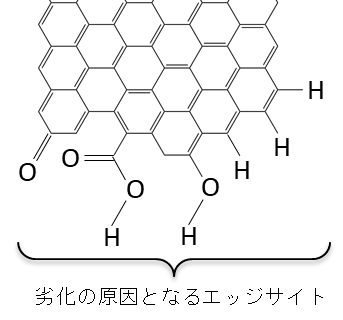News and Events
NEWS
Discovery of New Carbon Material to Extend Lithium Air Battery Life Graphene Mesosponge Overcomes Degradation of Conventional Carbon Cathode
Press Release 20230410
Key Points of the Announcement
A material that overcomes the degradation of carbon cathode, which is a challenge for the practical application of lithium-air batteries, has been discovered.
Using a new carbon material, graphene mesosponge (GMS), a high capacity of 6700 mAh/g and a charge-discharge cycle life more than six times longer than that of existing carbon cathode materials have been achieved.
The topological defect structure that gives GMS its high performance was elucidated both theoretically and experimentally.
Summary
Lithium-air batteries are next-generation storage batteries that are expected to achieve energy densities several times higher than current lithium-ion batteries, but their severe degradation and inability to be repeatedly charged and discharged have been major issues. In this research, an interdisciplinary research team from Tohoku University, Shinshu University, Okayama University, Osaka University, Institute of Inorganic Chemistry of Slovak Academy of Sciences, University of Natural Resources and Life Sciences (Austria), and Shanghai Tech University (China) has developed a new carbon cathode material to extend the life of lithium air batteries.
Lithium air batteries use carbon material for the positive electrode and lithium metal for the negative electrode, and charge and discharge are performed by the deposition and decomposition of lithium peroxide on the positive electrode. A wide variety of carbon cathode materials such as carbon black, carbon nanotubes, and activated carbon have been investigated, but the major issue is that all of these materials deteriorate quickly and cannot be repeatedly charged and discharged. In this research, by using graphene mesosponge (GMS), a new carbon material developed by Tohoku University for the first time in the world, for the cathode, the capacity of 6700 mAh/g was achieved, far exceeding the capacity of carbon cathode materials reported so far, and the charge-discharge cycle life was six times longer than that of conventional carbon cathodes cycle life of more than six times longer than that of conventional carbon cathode. Furthermore, by precisely analyzing the nanostructure of GMS using advanced analytical methods, mathematical analysis, and theoretical calculations, we have clarified the material design guidelines for achieving both high performance and high durability.
In the future, this research is expected to lead to the practical application of lithium-air batteries in the long term.
The research results were published in the scientific journal Advanced Science on April 10, 2023 (local time).
-

(The original press release is in Japanese)
http://www.tohoku.ac.jp/japanese/2023/04/press20230410-02-carbon.html https://www.wpi-aimr.tohoku.ac.jp/jp/achievements/press/2023/20230410_001600.html
Publication details
Title:
Edge-Site-Free and Topological-Defect-Rich Carbon Cathode for High-Performance Lithium-Oxygen Batteries
Authors
Wei Yu, Takeharu Yoshii, Alex Aziz, Rui Tang, Zheng-Ze Pan, Kazutoshi Inoue, Motoko Kotani, Hideki Tanaka, Eva Scholtzová, Daniel Tunega, Yuta Nishina, Kiho Nishioka, Shuji Nakanishi, Yi Zhou, Osamu Terasaki, Hirotomo Nishihara
Journal
Advanced Science, 2300268, 2023
DOI
Contact
(Research)
Professor Hirotomo NISHIHARA
E-mail: hirotomo.nishihara.b1[at]tohoku.ac.jp
Please replace [at] with "@" in the email address.
(Press)
E-mail: aimr-outreach[at]grp.tohoku.ac.jp
Please replace [at] with "@" in the email address.
